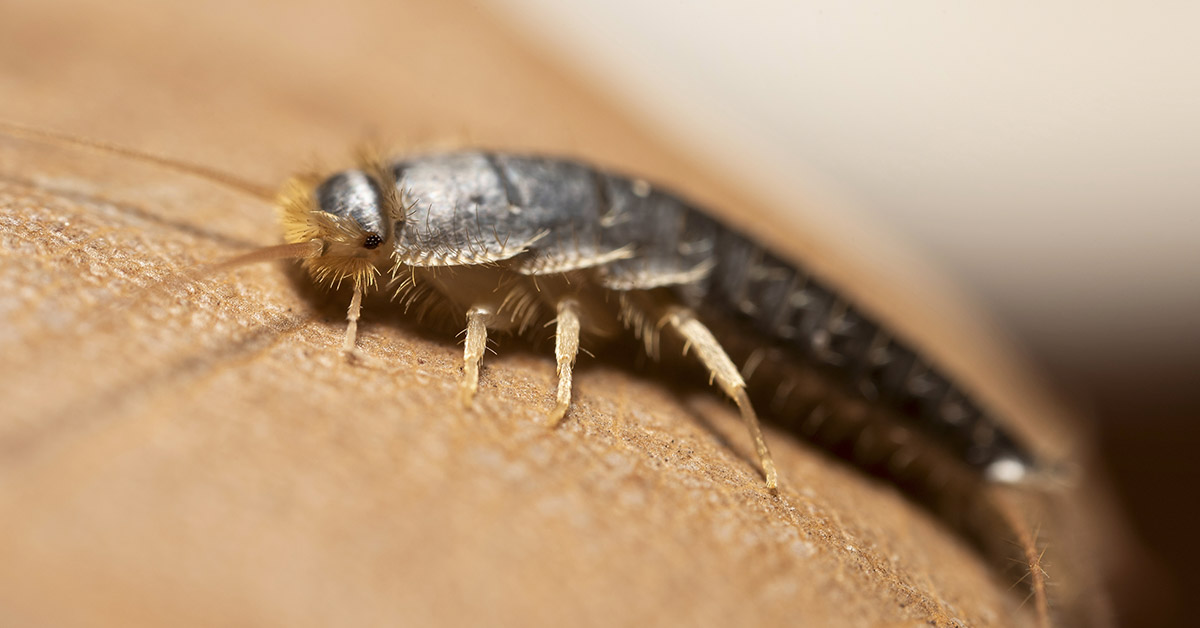Experts are warning households about the potential risks of a tiny silver insect known as the silverfish. Although small in size, this unassuming creature could pose significant challenges if overlooked. Resembling a teardrop in shape, these bugs are generally harmless to humans and do not directly cause damage to your home.
Silverfish derive their name from the distinctive coloration of their scales, which can appear silver or metallic brown. These insects have long, narrow bodies, usually measuring between 0.47 to 0.74 inches. Resembling the shape of a fish, they have six legs and two antennae. In addition to their common name, silverfish, they are sometimes referred to as bristletails due to the three long bristles at the end of their bodies.

While silverfish are of no real harm to us, aside from allergies, they do warn of a bigger problem
The presence of silverfish insects serves as an indicator rather than the direct problem itself. And it is unnecessary to get rid of them. However, their appearance signals that a household may be experiencing issues related to dampness.
Silverfish thrive in environments with high moisture content and are commonly found near water sources. If you spot these silver critters crawling in or out of your skirting boards or around window sills, it could be an indication of moisture within your property.
Neglecting to address the dampness can lead to further issues for households. These may include the cracking of bricks, the decay of plaster, and the rotting of joists.
Several factors can contribute to the presence of dampness. These range from leaky drain pipes to condensation, aging, damp-proofing systems, or poor ventilation. Rooms such as bathrooms and kitchens, where water tends to gather, are particularly susceptible to poor ventilation and increased moisture levels in the air.
The warning came as the National Trust was alerted to some concerning issues in the UK
The National Trust has issued a warning about the vulnerability of the nation’s historic houses and their precious artifacts. These are currently facing an onslaught from an army of insects. Among the pests causing damage, silverfish have been implicated in the deterioration of various valuable items such as 18th-century furniture, rare Chinese wallpaper, and even the knickerbockers worn by playwright George Bernard Shaw.
According to a pest control expert, the presence of silverfish serves as a sign of a water leak within a home. It is not uncommon for individuals to mistake these agile insects for roaches due to their rapid movements. “Although silverfish are completely harmless they’re actually worse than roaches because it means there’s a much bigger problem in the house.” He said.
“When people see these bugs, it’s not the insects they should be worrying about. They should be worried about sorting it out. Or getting the landlord to sort out the leaking roof or shower or whatever is causing the damp and mold.” He continued.
Read: How to get rid of ants as pest control expert says warm weather is making them enter your home
Silverfish can cause allergies in some households. So it is worth noting that one should ideally try to get rid of them along with the mold problem
Silverfish have a varied diet and feed on the sugar and starch content present in a wide range of household items. These include books, photographs, documents, and wallpaper. Additionally, items such as soap, hair, dandruff, and dust can serve as food sources for silverfish.
They are known to consume glue, clothing made of silk, cotton, and linen, and various food products such as dried beef, coffee, sugar, and carb-rich items like flour and rolled oats. Despite their dietary preferences, silverfish are generally reclusive and will actively avoid human presence.
They lack the ability to fly or bite, but their impressive running speed allows them to swiftly navigate their environment. It is worth noting that their rapid breeding can lead to infestations growing quickly if left unaddressed.

According to a study conducted in 2015, individuals with silverfish allergies may experience respiratory symptoms. The shed scales of silverfish contain a protein called tropomyosin, which can combine with other allergens and potentially trigger allergic reactions. Additionally, some individuals may also be allergic to the droppings of silverfish. These allergenic components can lead to respiratory symptoms in some individuals.
A few tips on getting rid of silverfish. From Chemicals to more natural remedies
While getting rid of silverfish won’t solve the issue of dampness, some people would rather their homes be free of these pesky things.
Chemical baits: Silverfish can be picky in their feeding habits and may not be easily attracted to commercial baits. As a result, typical commercial baits may not work against silverfish. Moreover, they have the ability to survive for long periods without needing food or water. This means that they will not be pushed to consume bait solely due to hunger.
In the case of large infestations, insecticides can be used. However, it is important to note that they may not be effective as long as suitable habitats for silverfish are still present. Simply relying on insecticides without addressing the underlying conducive conditions can limit their effectiveness in controlling their populations.
Natural methods you may wish to try
For those who prefer natural methods to get rid of silverfish, initial steps focus on reducing moisture and humidity levels in the affected area. Using a dehumidifier effectively lowers the humidity to levels that make the environment unfavorable for silverfish. By creating a drier atmosphere, it becomes less habitable for these insects.
Another important step is to get rid of dark hiding places where silverfish can reside. Clearing out these spaces reduces the number of potential shelters for them, making it more difficult for them to thrive. Implementing these measures can help create an environment that discourages silverfish infestations without the immediate need for chemical interventions.
Anecdotal evidence suggests that certain natural ingredients can potentially repel silverfish. These include:
Cedar shavings: Silverfish are believed to be repelled by the scent of cedar. Placing cedar shavings in areas where silverfish are present may discourage their presence.
Cedar oil and water: A mixture of cedar oil and water can be used as a natural repellent. Spraying this solution in areas prone to solve rfish activity may help deter them.
Cinnamon: The strong aroma of cinnamon is said to be disliked by silverfish. Sprinkling cinnamon in affected areas or creating sachets with cinnamon sticks can discourage silverfish.
Cloves: Similar to cinnamon, the smell of cloves is believed to repel silverfish. Placing whole cloves in infested areas or using clove essential oil can act as a deterrent.

Additionally, diatomaceous earth (DE), a powder made from fossilized algae, can be effective in controlling small infestations. DE works by dehydrating silverfish upon contact and eventually causing their demise. It is generally considered safe for humans and pets.
Traps using sticky tape or boric acid can also be helpful for small infestations. However, it is important to note that boric acid is toxic if ingested by humans or pets and should be used with caution. While these natural remedies may have some repellent effects, their efficacy may vary, and it’s important to remember that they may not completely eradicate a silverfish infestation.
And if all else fails, seeking the help of a professional pest control company is also an option
If traditional methods such as chemical baits or natural remedies prove ineffective in addressing a silverfish infestation, it is advisable to seek assistance from a licensed pest control professional. Contacting a local pest control company will allow you to consult with professionals experienced in dealing with various pest infestations, including silverfish.
They will assess the severity of the infestation and recommend appropriate treatment options tailored to your specific situation. A licensed pest control professional will have the knowledge, expertise, and access to effective products or methods to effectively manage and eliminate the silverfish infestation. They can provide guidance on the best course of action and take steps to mitigate the issue appropriately.
Keep Reading: How to get rid of fruit flies and gnats
Sources
- “The tiny silver insect which could mean your home has a huge and expensive problem.” GB News. Georgina Cutler. May 16, 2023
- “What silverfish are and how to get rid of them.” Medical News Today. Lois Zoppi. February 8, 2021.

